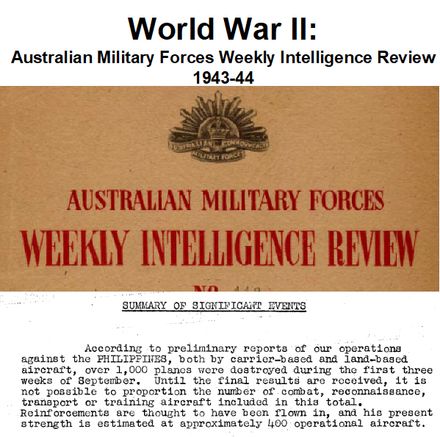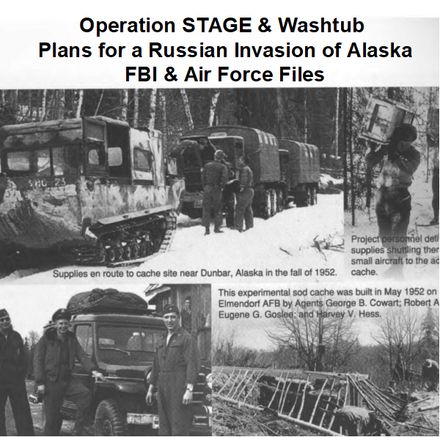Starting from:
$14.95
Home
Atomic - Nuclear
WWII War Office of Scientific Research and Development Atomic Bomb Development Bush-Conant Papers
WWII War Office of Scientific Research and Development Atomic Bomb Development Bush-Conant Papers
1 reviews
World War II:
Office of Scientific Research and Development
Atomic Bomb Development Bush-Conant Papers
12,700 pages of the Vannevar Bush and James Conant Files relating to the development of the atomic bomb, copied from materials held at the National Archives and Records Administration.
These records were maintained in Dr. James B. Conant's office for himself and Dr. Vannevar Bush. The files date from 1939 to 1947, with most documents dating between 1940 and 1945.
The files are mostly composed of letters, memorandums, reports, and technical reports relating to the development of the atomic bomb. The material includes correspondence from high-ranking government and military officials and eminent American and British scientists and industrial engineers connected with the atomic bomb project. This project, until it was turned over to the army, was referred to by the code names "uranium," "S-1," or "tube alloys" (the British code name).
The subject matter of the Bush-Conant File relates to scientific and technical problems; research and development (R & D) contracts with universities and private industry and associated fiscal, personnel, and security matters; relations with the British in the Allies' race to develop nuclear weapons before the Germans did; legislation and plans for postwar development and control of atomic energy; and official government policy.
The Bush-Conant Files document OSRD's role in promoting basic scientific research and development on nuclear fission before August 1942. In addition, the files document Bush and Conant's continuing roles, as chairman and alternate chairman of the Military Policy Committee, in overseeing the army's development of the atomic bomb during World War II and, as members of the short-lived Interim Committee, in advising on foreign policy and domestic legislation for the regulation of atomic energy immediately after the war.
The collection includes finding aids consisting of an Annotated Folder Title List (Appendix A), an index (Appendix B), and a Folder Contents List. The Annotated Folder Title List and the index were prepared by the National Archives. The Folder Contents List was prepared by the Historian's Office of the Atomic Energy Commission when the records were shipped to the National Archives. It designates memorandums and letters by sender, recipient, and date.
The disc contains a text transcript of all computer recognizable text embedded into the graphic image of each page of each document, creating a searchable finding aid. Text searches can be done across all files on the disc.
ABOUT DR. VANNEVAR BUSH AND DR. JAMES B. CONANT
Vannevar Bush was among the preeminent American scientists of the first half of the twentieth century. Bush by 1938 had: founded the company now known as Raytheon; constructed an analog computer with some digital components that could solve differential equations; became Vice President of MIT and Dean of the MIT School of Engineering; was appointed to the National Advisory Committee for Aeronautics; became president of the Carnegie Institution, America's leading science foundation in 1938.
Vannevar Bush was appointed Chairman of the National Defense Research Committee (NDRC) in 1940 and in 1941 as Director of the Office of Scientific Research and Development (OSRD). Bush administrated the activities of over six thousand scientists working to apply science to warfare. As head of OSRD he can be considered as President Roosevelt's and President Truman's science advisor. Bush initiated a crash program to create an atomic bomb which evolved into the Manhattan Project and worked to make certain it maintained a high priority.
James Conant, the president of Harvard, was recruited by then director of the Carnegie Institution of Washington, Vannevar Bush to join the soon to be created National Defense Research Committee, and Conant became its chairman in 1941. The NDRC purpose was to coordinate, supervise, and conduct scientific research on the problems underlying the development, production, and use of mechanisms and devices of warfare. It was replaced by the Office of Scientific Research and Development in 1941 where Conant remained chairman and Vannevar Bush was director.
Conant managed the development of synthetic rubber, and atomic bomb research which would later become the Manhattan Project. He was present at the Alamogordo Bombing and Gunnery Range on July 16, 1945 for the Trinity atomic test. He was a member of the Interim Committee that advised President Truman on the use of atomic bombs on Japan.
In February 1941, Conant went to England to meet with his British counterparts. He learned from Prime Minister Churchill's chief scientific advisor Frederick Lindemann that Britain was years ahead of America on nuclear fission. This was mostly due to the fact that British scientists strongly believed that atomic weapons were feasible. Conant feared that Germany may have been even further ahead because of its reputation in the field of nuclear physics.
On October 9, 1941 Vannevar Bush meet with President Roosevelt and informed him on Tube Alloys, the British atomic bomb project, and its Maud Committee's work on an atomic bomb, and on the German nuclear energy project, which was mostly a mystery. Roosevelt soon approved and expedited the atomic program.
HISTORY OF THE FILES
These records were withheld by Bush and Conant as a personal file in 1946 when the OSRD S-1 Section files were transferred to Oak Ridge. The Bush-Conant File was then transferred to the Atomic Energy Commission in a locked safe when the OSRD was disbanded in 1947. When the AEC moved to Germantown this safe disappeared, only to be rediscovered several years later under a stairwell in one of the AEC buildings. At the time this mysterious locked safe was discovered by an AEC records officer, the origin and contents were unknown. Dr. Richard Hewlett, the AEC historian, was invited to witness its opening by a locksmith hired for the purpose. According to Hewlett, the first item he pulled from the file was a letter signed by Franklin D. Roosevelt. The discovery of these documents, according to James P. Baxter, III, then Historical Advisory Committee Chairman for the AEC, "made possible for the first time a satisfactory account of the intricate wartime negotiations with Great Britain and Canada on atomic energy."
The Bush-Conant File was transferred to the National Archives in 1973, along with other S-1 files of the OSRD containing correspondence and technical reports on the development of the atomic bomb.
ARRANGEMENT OF THE FILES
The Bush-Conant File contains over 240 folders arranged in 2 sections. Section I, "Subject Files," consists of folders 1-22, which are arranged under four broad topics: Historical Overview of S-1 Program, 1939-45 (folders 1-7); U.S.-British Relations on Nuclear Energy, 1942-45 (folders 8-12); OSRD S-1 Program Administration, 1941-45 (folders 13-21); and Material Relating to a National Research Foundation, 1945 (folder 22). Section II, "DSM [Development of Substitute Materials] Alphabetical Subject Files," contains, as the title states, subject files arranged alphabetically.
It is believed that Section I consist of files made by Conant for his own personal use and that the Section II files were maintained in Conant's OSRD office by his secretary, Ruth Jenkins. The files in Section I, give a good historical overview of the development of the atomic bomb project. Folders 1 and 2 contain a two-part manuscript history of the S-1 Project, written by Conant and covering the period from May 17, 1941 through June 19, 1942. Also included in these two folders are the documents cited in his notes. Folder 3 contains documents originally intended to be used by Conant in a history of the OSRD, a project that Conant never completed.
Highlights include:
Correspondence concerning Albert Einstein and why he was not being included in the S-1 project, as well as two attempts to obtain certain theoretical data from Einstein without revealing its intended use.
Documents gathered to substantiate Conant's informal history of the S-1 (A-bomb) project, covering the period from May 17, 1941, to June 19, 1942. The documents include typewritten and handwritten copies of Conant's informal history and Conant's handwritten lists of important documents. Also included are copies of the three 1941 National Academy of Sciences reports on the feasibility of producing an atomic bomb.
Memorandums and letters between Vannevar Bush and Franklin D. Roosevelt; materials addressed to Bush or Arthur H. Compton describing the dissatisfaction with the S-1 project felt by some of the scientists associated with it; letters from Leo Szilard expressing his concern with the policy of compartmentalization adopted by the managers of the S-1 project and his possible patent rights. Correspondence notifying the British of the reorganization of the U.S. uranium program in December 1941 and British correspondence outlining the organization of their "Tube Alloys" program.
Reports summarizing information intercepted by intelligence sources on Germany's efforts toward manufacturing an atom bomb (see folders 7, 75, and 230) and a Sept. 25, 1945, memorandum discussing Bush's postwar thoughts on sharing basic scientific knowledge of atomic energy with the Russians.
Oct. 20, 1944, memorandum from Conant to Bush concerning the "possibilities of a Super Bomb [i.e., hydrogen bomb]" and a Dec. 15, 1942, memorandum from Conant to Bush on the possibility that plutonium might prove to be a "super-explosive."
A formerly Top Secret file of Bush-related materials, consisting primarily of memorandums from Bush to Conant on the international implications of the A-Bomb, biological warfare, Conant's eyewitness account of the Trinity Test, and June 1943 draft letters to serve as morale boosters for project scientists to Groves and Oppenheimer from the President.
Letter from A. H. Compton to J. B. Conant about the Chicago Radiation Laboratory's plans for protecting the health of its personnel and about conducting further research on radiation hazards.
Correspondence pertaining to the procurement of scientists desired by J. Robert Oppenheimer for the Los Alamos Project, Bush's request to know exactly who had knowledge of the ultimate purpose of Oppenheimer's assignment, and a copy of the War Department's May 13, 1942, security notice on Oppenheimer.
Memo to Vannevar Bush on the placing of the Committee on Uranium under the control of the National Defense Research Committee
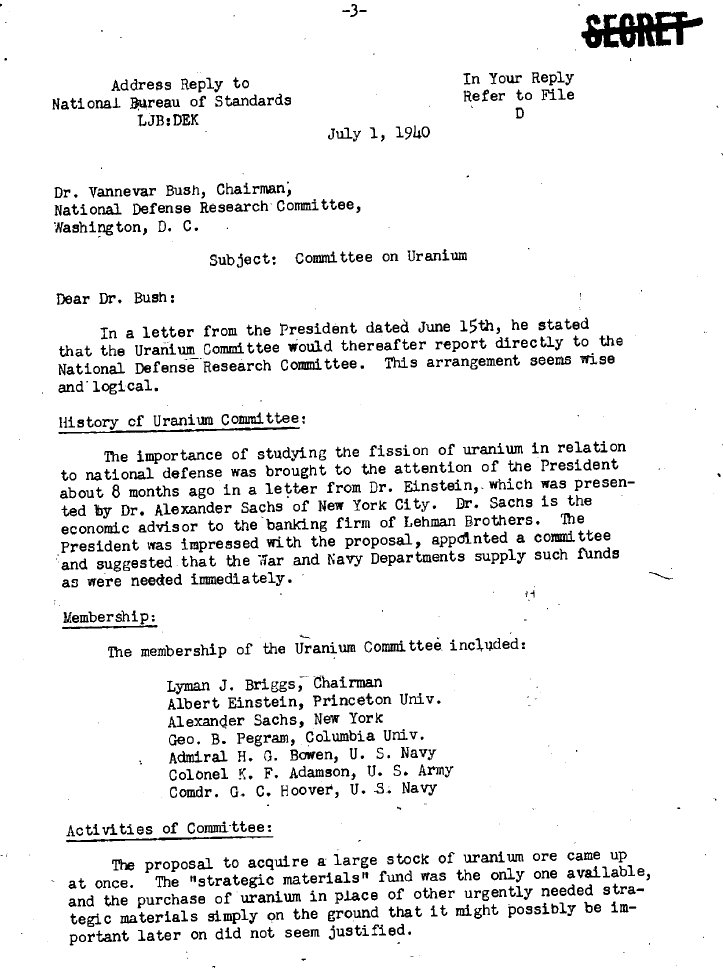
Memo to Vannevar Bush on the gap between the United States and England in nuclear physics
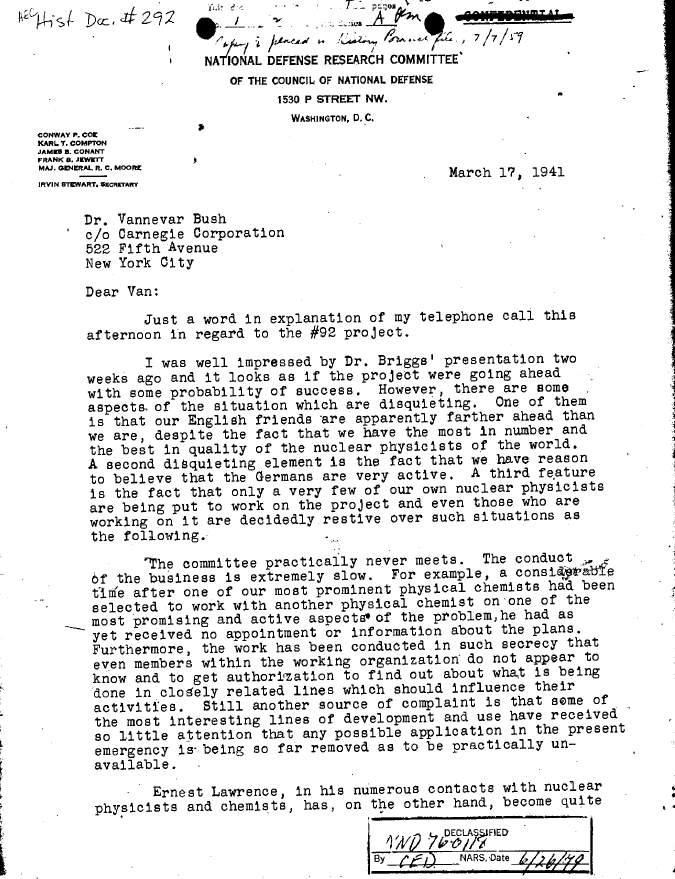
Memo on efforts to get information from Albert Einstein to aid the development of the atomic weapon
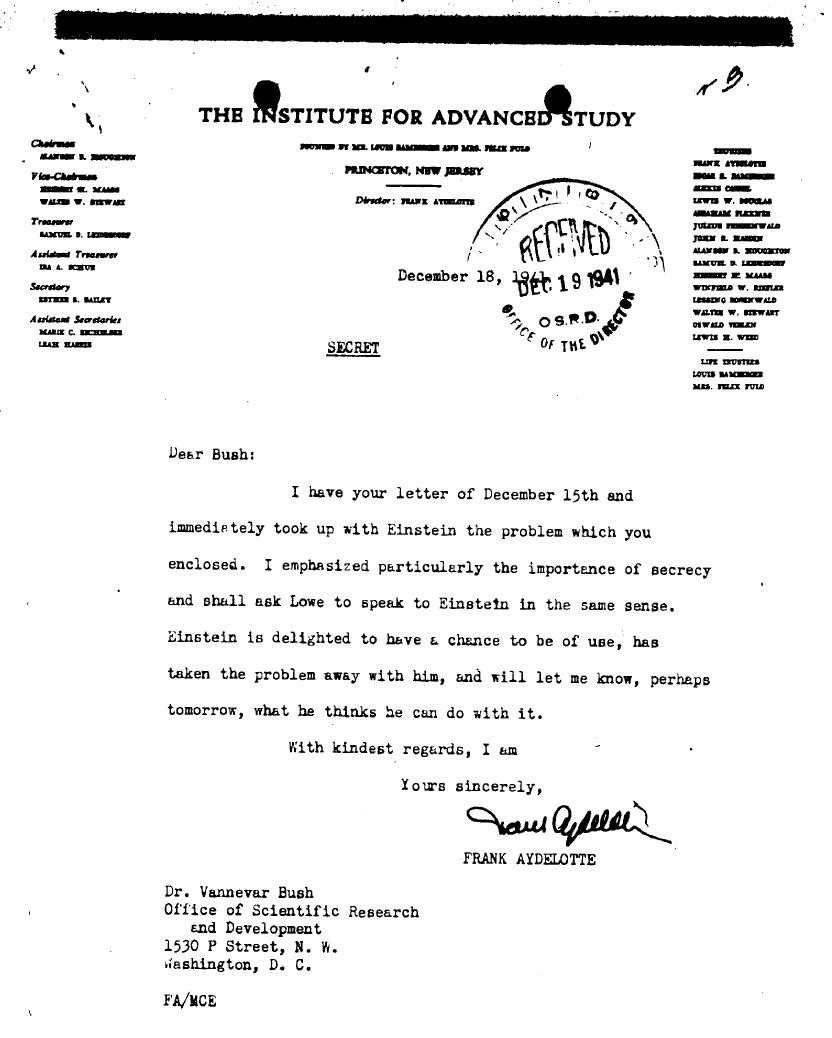
Memo concerning correspondence from Leo Szilard addressing patent rights
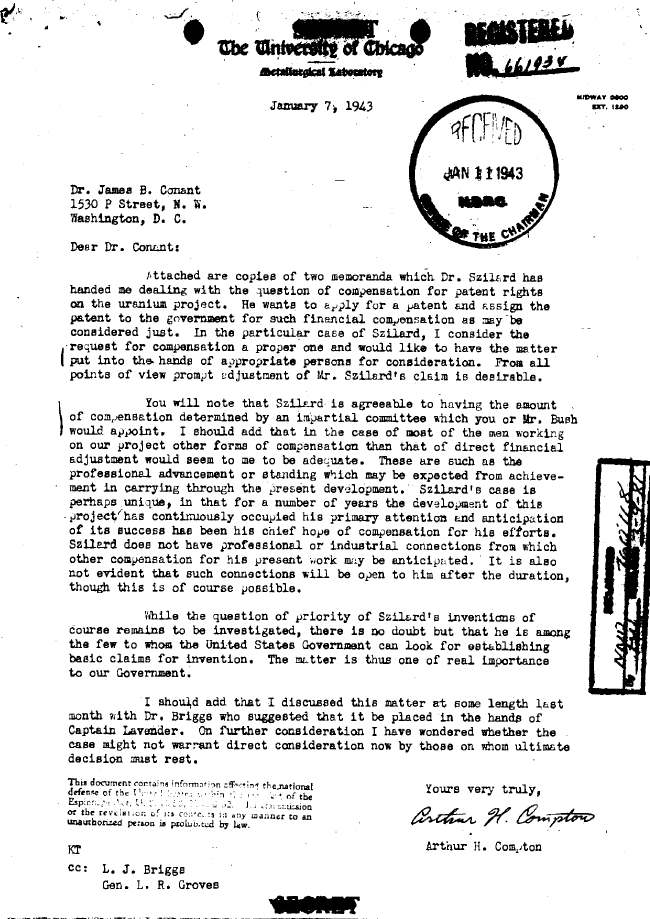
Memo showing strain in information channel between the Americans and the British
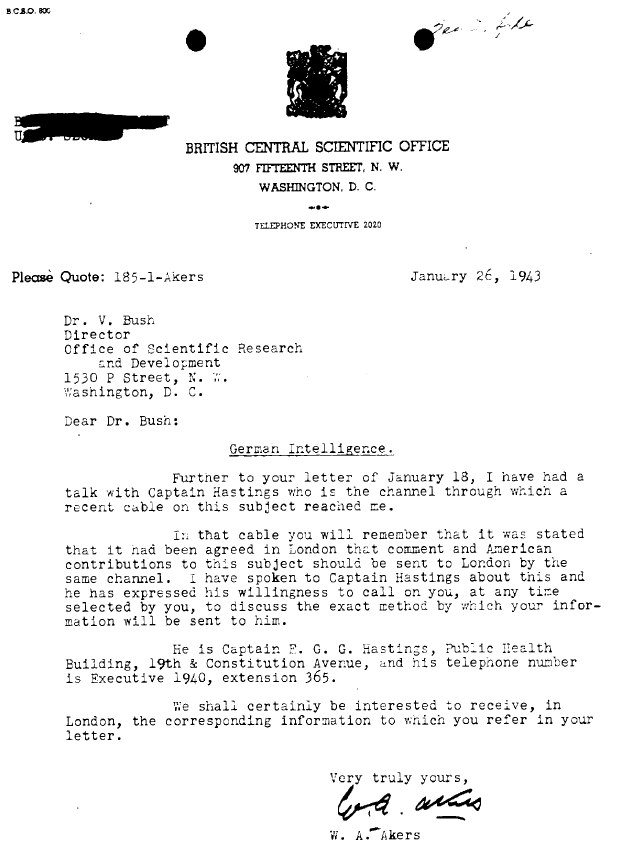
Memo on conference with President Roosevelt
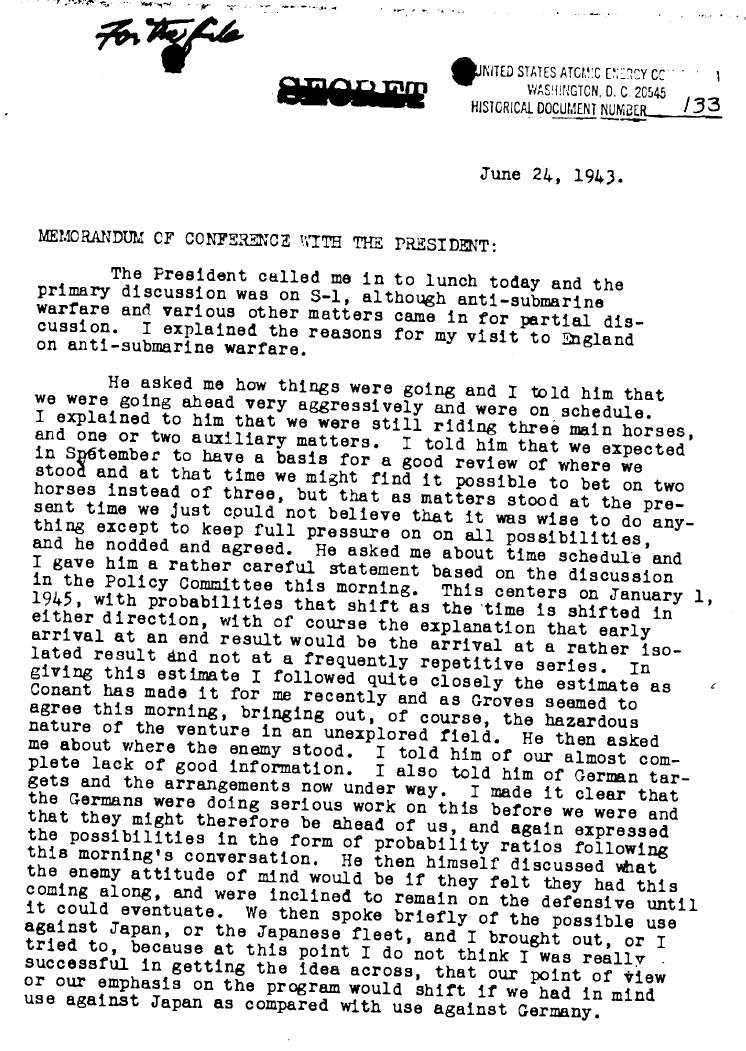
Memo from President Roosevelt to Vannevar Bush seeking to expand the information being shared with the British
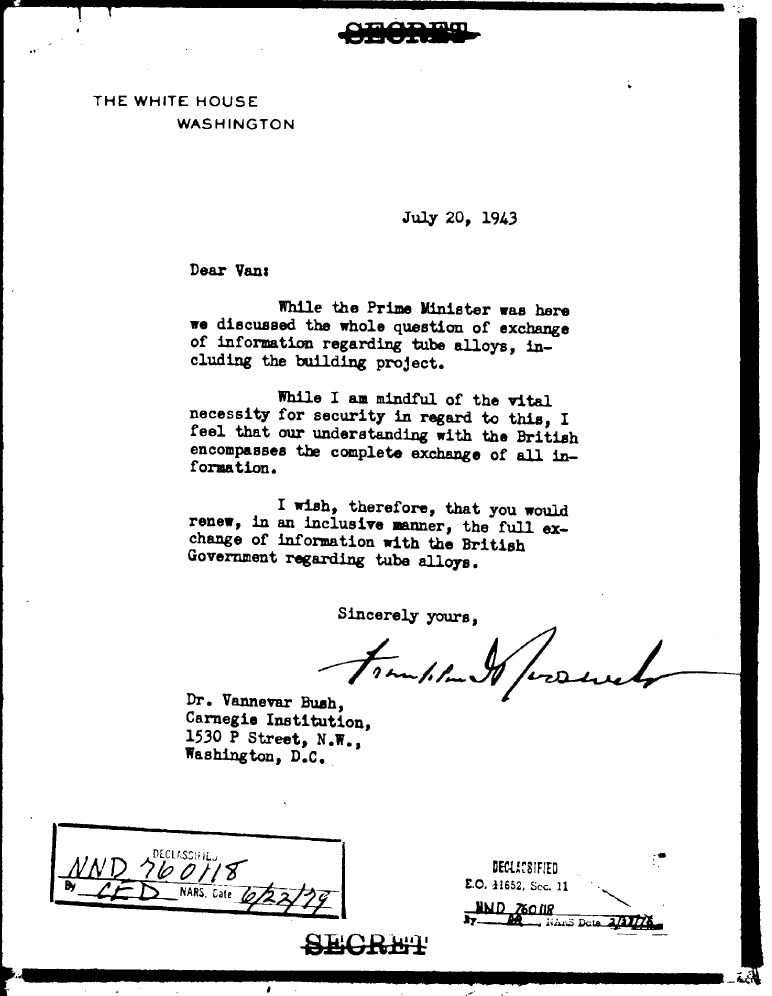
Office of Scientific Research and Development
Atomic Bomb Development Bush-Conant Papers
12,700 pages of the Vannevar Bush and James Conant Files relating to the development of the atomic bomb, copied from materials held at the National Archives and Records Administration.
These records were maintained in Dr. James B. Conant's office for himself and Dr. Vannevar Bush. The files date from 1939 to 1947, with most documents dating between 1940 and 1945.
The files are mostly composed of letters, memorandums, reports, and technical reports relating to the development of the atomic bomb. The material includes correspondence from high-ranking government and military officials and eminent American and British scientists and industrial engineers connected with the atomic bomb project. This project, until it was turned over to the army, was referred to by the code names "uranium," "S-1," or "tube alloys" (the British code name).
The subject matter of the Bush-Conant File relates to scientific and technical problems; research and development (R & D) contracts with universities and private industry and associated fiscal, personnel, and security matters; relations with the British in the Allies' race to develop nuclear weapons before the Germans did; legislation and plans for postwar development and control of atomic energy; and official government policy.
The Bush-Conant Files document OSRD's role in promoting basic scientific research and development on nuclear fission before August 1942. In addition, the files document Bush and Conant's continuing roles, as chairman and alternate chairman of the Military Policy Committee, in overseeing the army's development of the atomic bomb during World War II and, as members of the short-lived Interim Committee, in advising on foreign policy and domestic legislation for the regulation of atomic energy immediately after the war.
The collection includes finding aids consisting of an Annotated Folder Title List (Appendix A), an index (Appendix B), and a Folder Contents List. The Annotated Folder Title List and the index were prepared by the National Archives. The Folder Contents List was prepared by the Historian's Office of the Atomic Energy Commission when the records were shipped to the National Archives. It designates memorandums and letters by sender, recipient, and date.
The disc contains a text transcript of all computer recognizable text embedded into the graphic image of each page of each document, creating a searchable finding aid. Text searches can be done across all files on the disc.
ABOUT DR. VANNEVAR BUSH AND DR. JAMES B. CONANT
Vannevar Bush was among the preeminent American scientists of the first half of the twentieth century. Bush by 1938 had: founded the company now known as Raytheon; constructed an analog computer with some digital components that could solve differential equations; became Vice President of MIT and Dean of the MIT School of Engineering; was appointed to the National Advisory Committee for Aeronautics; became president of the Carnegie Institution, America's leading science foundation in 1938.
Vannevar Bush was appointed Chairman of the National Defense Research Committee (NDRC) in 1940 and in 1941 as Director of the Office of Scientific Research and Development (OSRD). Bush administrated the activities of over six thousand scientists working to apply science to warfare. As head of OSRD he can be considered as President Roosevelt's and President Truman's science advisor. Bush initiated a crash program to create an atomic bomb which evolved into the Manhattan Project and worked to make certain it maintained a high priority.
James Conant, the president of Harvard, was recruited by then director of the Carnegie Institution of Washington, Vannevar Bush to join the soon to be created National Defense Research Committee, and Conant became its chairman in 1941. The NDRC purpose was to coordinate, supervise, and conduct scientific research on the problems underlying the development, production, and use of mechanisms and devices of warfare. It was replaced by the Office of Scientific Research and Development in 1941 where Conant remained chairman and Vannevar Bush was director.
Conant managed the development of synthetic rubber, and atomic bomb research which would later become the Manhattan Project. He was present at the Alamogordo Bombing and Gunnery Range on July 16, 1945 for the Trinity atomic test. He was a member of the Interim Committee that advised President Truman on the use of atomic bombs on Japan.
In February 1941, Conant went to England to meet with his British counterparts. He learned from Prime Minister Churchill's chief scientific advisor Frederick Lindemann that Britain was years ahead of America on nuclear fission. This was mostly due to the fact that British scientists strongly believed that atomic weapons were feasible. Conant feared that Germany may have been even further ahead because of its reputation in the field of nuclear physics.
On October 9, 1941 Vannevar Bush meet with President Roosevelt and informed him on Tube Alloys, the British atomic bomb project, and its Maud Committee's work on an atomic bomb, and on the German nuclear energy project, which was mostly a mystery. Roosevelt soon approved and expedited the atomic program.
HISTORY OF THE FILES
These records were withheld by Bush and Conant as a personal file in 1946 when the OSRD S-1 Section files were transferred to Oak Ridge. The Bush-Conant File was then transferred to the Atomic Energy Commission in a locked safe when the OSRD was disbanded in 1947. When the AEC moved to Germantown this safe disappeared, only to be rediscovered several years later under a stairwell in one of the AEC buildings. At the time this mysterious locked safe was discovered by an AEC records officer, the origin and contents were unknown. Dr. Richard Hewlett, the AEC historian, was invited to witness its opening by a locksmith hired for the purpose. According to Hewlett, the first item he pulled from the file was a letter signed by Franklin D. Roosevelt. The discovery of these documents, according to James P. Baxter, III, then Historical Advisory Committee Chairman for the AEC, "made possible for the first time a satisfactory account of the intricate wartime negotiations with Great Britain and Canada on atomic energy."
The Bush-Conant File was transferred to the National Archives in 1973, along with other S-1 files of the OSRD containing correspondence and technical reports on the development of the atomic bomb.
ARRANGEMENT OF THE FILES
The Bush-Conant File contains over 240 folders arranged in 2 sections. Section I, "Subject Files," consists of folders 1-22, which are arranged under four broad topics: Historical Overview of S-1 Program, 1939-45 (folders 1-7); U.S.-British Relations on Nuclear Energy, 1942-45 (folders 8-12); OSRD S-1 Program Administration, 1941-45 (folders 13-21); and Material Relating to a National Research Foundation, 1945 (folder 22). Section II, "DSM [Development of Substitute Materials] Alphabetical Subject Files," contains, as the title states, subject files arranged alphabetically.
It is believed that Section I consist of files made by Conant for his own personal use and that the Section II files were maintained in Conant's OSRD office by his secretary, Ruth Jenkins. The files in Section I, give a good historical overview of the development of the atomic bomb project. Folders 1 and 2 contain a two-part manuscript history of the S-1 Project, written by Conant and covering the period from May 17, 1941 through June 19, 1942. Also included in these two folders are the documents cited in his notes. Folder 3 contains documents originally intended to be used by Conant in a history of the OSRD, a project that Conant never completed.
Highlights include:
Correspondence concerning Albert Einstein and why he was not being included in the S-1 project, as well as two attempts to obtain certain theoretical data from Einstein without revealing its intended use.
Documents gathered to substantiate Conant's informal history of the S-1 (A-bomb) project, covering the period from May 17, 1941, to June 19, 1942. The documents include typewritten and handwritten copies of Conant's informal history and Conant's handwritten lists of important documents. Also included are copies of the three 1941 National Academy of Sciences reports on the feasibility of producing an atomic bomb.
Memorandums and letters between Vannevar Bush and Franklin D. Roosevelt; materials addressed to Bush or Arthur H. Compton describing the dissatisfaction with the S-1 project felt by some of the scientists associated with it; letters from Leo Szilard expressing his concern with the policy of compartmentalization adopted by the managers of the S-1 project and his possible patent rights. Correspondence notifying the British of the reorganization of the U.S. uranium program in December 1941 and British correspondence outlining the organization of their "Tube Alloys" program.
Reports summarizing information intercepted by intelligence sources on Germany's efforts toward manufacturing an atom bomb (see folders 7, 75, and 230) and a Sept. 25, 1945, memorandum discussing Bush's postwar thoughts on sharing basic scientific knowledge of atomic energy with the Russians.
Oct. 20, 1944, memorandum from Conant to Bush concerning the "possibilities of a Super Bomb [i.e., hydrogen bomb]" and a Dec. 15, 1942, memorandum from Conant to Bush on the possibility that plutonium might prove to be a "super-explosive."
A formerly Top Secret file of Bush-related materials, consisting primarily of memorandums from Bush to Conant on the international implications of the A-Bomb, biological warfare, Conant's eyewitness account of the Trinity Test, and June 1943 draft letters to serve as morale boosters for project scientists to Groves and Oppenheimer from the President.
Letter from A. H. Compton to J. B. Conant about the Chicago Radiation Laboratory's plans for protecting the health of its personnel and about conducting further research on radiation hazards.
Correspondence pertaining to the procurement of scientists desired by J. Robert Oppenheimer for the Los Alamos Project, Bush's request to know exactly who had knowledge of the ultimate purpose of Oppenheimer's assignment, and a copy of the War Department's May 13, 1942, security notice on Oppenheimer.
Memo to Vannevar Bush on the placing of the Committee on Uranium under the control of the National Defense Research Committee

Memo to Vannevar Bush on the gap between the United States and England in nuclear physics

Memo on efforts to get information from Albert Einstein to aid the development of the atomic weapon

Memo concerning correspondence from Leo Szilard addressing patent rights

Memo showing strain in information channel between the Americans and the British

Memo on conference with President Roosevelt

Memo from President Roosevelt to Vannevar Bush seeking to expand the information being shared with the British

1 file (579.3MB)

